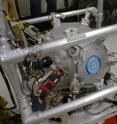Pioneering space station experiment keeps reactions in suspense
A revolutionary container-less chemical reactor, pioneered by the space research team at Guigné International Ltd (GIL) in Canada with scientists at the University of Bath, has been installed on the International Space Station. The reactor, named Space-DRUMS, uses beams of sound to position chemicals in mid-air so they don't come into contact with the walls of the container. Space-DRUMS is based on the DRUMS device (Dynamically Responding Ultrasonic Matrix System), originally developed by Professor Jacques Yves Guigné, Chief Scientist of GIL (now with PanGeo Subsea Inc) to survey the sea floor using sonar.
With participation from Professor Nick Pace from the University of Bath's Department of Physics, and aerospace industrial associates of GIL, Professor Guigné has adapted the system to enable scientists to produce new materials in zero-gravity without using a container.
Professor Guigné, who gained his PhD at Bath and is now a Visiting Professor in the University's Department of Physics, explained: "Space-DRUMS uses beams of sound energy to position solids or liquids which are floating in zero-gravity.
"If you've ever been to a really loud rock concert and stood in front of the speakers, you can actually feel the force of the sound when they turn up the volume. Space-DRUMS works like this but on a much gentler scale – the beams of sound energy work like invisible fingers that gently push the sample into the centre of the container so that it doesn't touch the walls.
"Space-DRUMS uses 20 of these 'fingers of sound' arranged within a dodecahedron configured reactor such that the positions of the samples can be adjusted accurately.
"This method of acoustic levitation means there is no chemical contamination from the container, which is vital for making ultra-pure materials such as temperature-resistant ceramics used in coatings for planes and engines."
The equipment was initially tested in a low-gravity environment created by the vertical climbing and nose-diving flight path of a KC135 aeroplane, nick-named the vomit comet, similar to that used to train astronauts.
Space-DRUMS was launched into space in partnership with NASA and installed on the International Space Station on 14 November, coinciding with the International Space Station's 10th anniversary celebrations. The final components will be sent into orbit in July 2009, with experiments starting shortly afterwards.
Professor Nick Pace said: "We are delighted that this key step has been achieved; we have waited several years to witness this milestone.
"The most exciting thing is that we can control the experiments from Earth. Our physics students will be able to use it as part of their final year projects – there aren't many universities that can offer their students a chance to conduct experiments in space!"
In addition to making new materials, Space-DRUMS will also be used to study the physics of turbulence, which has diverse applications such as predicting the paths of hurricanes and helping biopharmaceutical studies.
Deputy Director of the Centre for Space, Atmospheric & Oceanic Sciences at Bath, Dr Philippe Blondel explained: "Even with large computer clusters, the understanding of complex weather patterns is still limited. Using Space-DRUMS will help us to better understand the behaviour of complex systems like hurricanes, their interaction with the atmosphere and hopefully anticipate where a hurricane can go next.
"Bath is at the forefront of this pioneering technology and we are really privileged by this opportunity to do these ground-breaking experiments in space."

